
Japan just experienced its largest urban wildfire in nearly fifty years, and the speed of destruction left emergency responders scrambling to save what remained of an entire coastal neighborhood.
Quick Take
- A massive wildfire erupted in Saganoseki district, Oita City on November 18, 2025, destroying or damaging over 170 homes in hours
- Strong winds pushed the fire from a fishing port into residential and forested zones with devastating speed and scale
- More than 175 residents were evacuated, with one person reported missing and nearly 270 households losing power
- Over 200 firefighters and Japan Ground Self-Defense Force helicopters deployed in response to the largest fire in five decades
When Coastal Winds Turn Deadly
The evening of November 18 started like any other in Saganoseki, a fishing district nestled on Kyushu Island about 700 kilometers southwest of Tokyo. Then, around 5:40 PM, fire broke out near the fishing port. What happened next shocked a nation that rarely sees large-scale urban wildfires. Strong seasonal winds transformed a localized blaze into an inferno that would consume entire neighborhoods before nightfall, forcing authorities to declare it the most significant fire Japan had experienced in nearly five decades.
The Anatomy of Rapid Destruction
Geography sealed Saganoseki’s fate. The district sits at the intersection of densely packed residential areas and forested hills, creating the perfect conditions for a fire to accelerate beyond control. The fishing port origin point meant the blaze started in an area with limited escape routes for residents. As winds intensified, flames jumped from structure to structure with terrifying velocity. Within hours, over 170 homes lay destroyed or damaged. The fire’s expansion wasn’t gradual—it was explosive, leaving residents with minimal time to gather belongings or even understand the danger approaching their neighborhoods.
Emergency Response at Scale
Japan mobilized resources with military precision. Over 200 firefighters from local departments converged on the scene, supported by two Japan Ground Self-Defense Force helicopters dropping water on active flames. Prime Minister Sanae Takaichi pledged maximum government support, recognizing the historical significance of the disaster. Emergency shelters opened to accommodate 175 evacuated residents. The Fire and Disaster Management Agency took charge of investigation and coordination. Despite these efforts, the fire remained uncontained as of November 19, with crews working through the night to prevent further spread into untouched residential zones.
The Human Cost Continues Mounting
Numbers tell only part of the story. One person was reported missing, their fate unknown amid the chaos. Nearly 270 households lost electricity, plunging entire blocks into darkness. Residents watched decades of memories burn in real time. Families displaced from their homes faced uncertain futures, crowded into emergency shelters wondering if their neighborhoods would survive the night. Local businesses, particularly those connected to the fishing industry, faced potential ruin. The economic ripple effects would extend far beyond Saganoseki’s borders, affecting insurance companies, construction firms, and regional commerce.
Why This Fire Matters Beyond Japan
Japan’s rarity with large-scale urban wildfires makes this event a wake-up call. Climate patterns are shifting globally, potentially increasing wildfire risk in regions historically considered safe. The rapid spread despite modern firefighting capabilities raises questions about urban planning near forested areas. Experts now scrutinize whether existing fire prevention protocols adequately address the urban-forest interface vulnerability. The cause remains under investigation, but the investigation itself signals that authorities must understand what allowed conditions to deteriorate so quickly. This fire will likely trigger policy reviews affecting disaster preparedness across Japan and potentially influence international urban planning standards.
As cleanup and recovery efforts begin, Saganoseki residents face a long road ahead. The fire that consumed their homes in hours will consume their attention for years. Japan’s response to this disaster will define how prepared the nation truly is for an uncertain environmental future.
Sources:
Fire burning in southwestern Japan damages 170 homes and forces evacuations






